I buried the bone in my backyard, under the Japanese maple tree, as Puma told me to. I would have thought the offering should be left in the wilderness, in the high places, close to the mountain gods. But no, under this tree in our tiny yard, the dense weave of city life just beyond the fence. When I listened, I heard: that was what Puma wanted.
Thirteen years before, I was given an unexpected gift that set me on the path of the story-carrier. It all started at Raqchi, an Inca site in the Peruvian highlands between Lake Titicaca and Cusco. That was where Mara found me.
I was 26 years old, a Jewish girl who grew up in a desert presided over by Joshua trees, ravens and tortoises. I was a traveler passing through the Andes, learning for the first time about this land of condor, puma and snake. These travels were for me a period of deep listening, opening to a call that could easily go unheard.
Raqchi. April 2002, autumn south of the equator.
I wander a long grassy aisle in what our tour guide called the women’s quarter. Thick walls rise on either side of me, each stone fit against the next in a tight embrace. Above the stonework soars smooth adobe. Doorways lead into identical roofless rooms. I pause at the entrance to one. A little breeze sweeps through, touching my hair, bringing with it the smell of crushed grass. I look around. My boyfriend Mikhail is nowhere in sight.
I step through the doorway. Inside, the air is quiet and still, sheltered by all that rock. There are three trapezoidal niches set into the wall. I sit in the corner near them. The stone wall at my back is surprisingly warm, still holding heat from the afternoon sun. I rest against it; my eyes close.
My fingers weave down into the thick pad of grass. Fingertips graze something hard. I work my hand around it, the smooth oval shape of a pebble revealed. I draw the stone to the surface. It fits perfectly in the hollow of my palm.
And then, I feel her — another presence, in the room with me.
Although I was a writer living in Berkeley, I didn’t think spirits talked to me. I believed the short stories I wrote came from my own creativity, inspired by the world around me. I considered the Muse a concept, an idea, not an ancient spirit who would hand me a story when I picked up a rock. There were no formal introductions: “Hello, my name is Mara and I’ll be your spirit guide for the next several decades.” Instead, a vision of a woman and her story shimmered on the hushed air — gauzy, diaphanous, the echo of a dream.
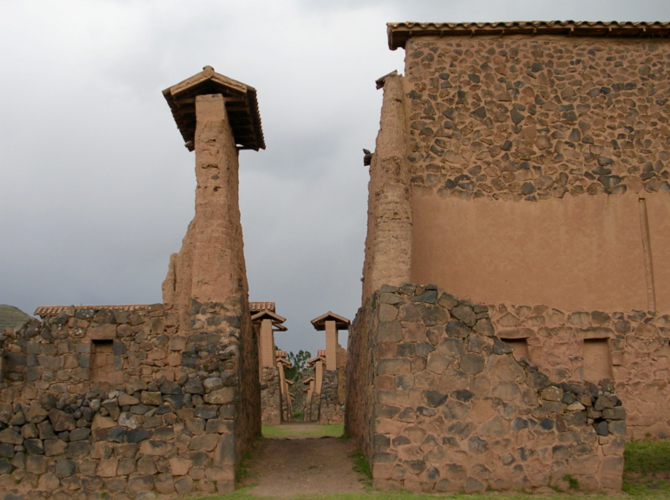 The “women’s quarter” at Raqchi, Peru (tile roofs are not original)
The “women’s quarter” at Raqchi, Peru (tile roofs are not original)
Rock, that bare, unadorned essence of a place, retains its character no matter how it is manipulated. The wall at my back, the pebble in my hand. They hold the memory of her still. My hand touches the imprint left by her hand centuries ago. Six hundred years.
She chooses me.
I loosen my grip on the pebble. Impossible.
Raqchi was my first step into the region dominated by the mountain Ausangate. Rising above the landscape, Ausangate is not just a mountain, he is an Apu — a sacred peak permanently covered in snow and ice, a mountain god.
For the Incas, and for many Andeans still, the gods are not mythical beings; they are forces of nature with whom the people have intimate, complicated relationships based on reciprocity and offering. They are spirits whose moods and tempers can change the course of lives in the extreme, highland climate of the Andes. Gods who need to be pleased and appeased, and who can call forth blessings or curses on those who people their world.
In Mara’s world, a place where everything is alive, the lines of the sacred and mundane weave together. The condor is an animal, yes, but he might also be a helper of the Apu, sent out from the mountain’s icy folds to see the world beyond his gaze. The snake is a snake, but he is also a spirit of the underworld, connected to the dark and deep places of Pachamama, the Earth Mother. Sun, Moon, Thunder: these are both gods and the natural forces that shape peoples’ lives.
“There you are,” Mikhail says. “It’s time to go.”
I want to sleep here, curled up with the taste of ancient stone in my mouth. But Raqchi is a ruin now, governed by the rules of tourism, and it closes at night.
Mikhail comes into the room and helps me to my feet. My jeans are damp from the grass. We walk down the aisle. The color of the sky is deepening as the blue hour approaches. This has never changed: the slow onset of night.
Suddenly, I realize the pebble is still in my hand. “Hold on,” I say. “I’ll be right back.”
When I turn, the rooms are shadowy past identical doorways. I take a few steps, afraid I won’t be able to find the right one. Is it really so important? But I sense it is. She is waiting.
I keep walking. There, on my left. I know that’s the room. I step inside. The smell of crushed grass welcomes me. I leave the pebble in the center niche. Her gift. My offering.
Though I had not been in the Andes long, I was beginning to understand that the culture was rooted in duality, reciprocity and the pervasive power of offerings. Andeans often use the word pago instead of the more formal ofrenda. Pago means “payment,” but the concept goes beyond our idea of a payment as part of a simple transaction. To many Andeans, even today and no matter how Catholic or non-traditional they are, leaving a pago is a gesture that is simply part of life. It is a thanks and a praise, a query and a prayer, a wish and a plea. It is a way of marking a moment. From the simple drop of alcohol spilled on the ground to Pachamama, to a quintu of coca leaves at a crossroads, to a complex offering given in a high place in the company of fellow devotees, leaving a pago is a way that Andeans assert over and over again their part of an ongoing relationship of reciprocity with the powerful forces of nature that surround them.
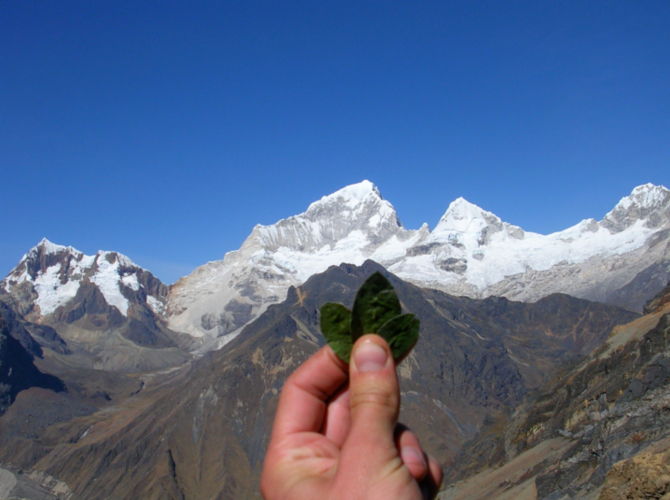 A quintu, trio of coca leaves, as a pago to an Apu, Peru
A quintu, trio of coca leaves, as a pago to an Apu, Peru
We go to Cusco, once the Inca capital, navel of one of the world’s great empires. I fall in love with the city, and it reciprocates with a horrible bout of traveler’s illness. As I float on waves of fever and nausea, Mara stays beside me.
Visions of her girlhood in a remote canyon of the altiplano mingle with the shouts of children playing in the schoolyard behind our hostel. She is a chosen woman — first by the Apu to be a seer, and then by the Incas to become an aklla, a woman who serves the gods and the Empire.
I take powerful antibiotics and slowly recover. Mikhail and I hike the Inca Trail to Machu Picchu. Mara walks alongside me, layering her story over the tour guide’s explanations. She is a woman trying to find her way in a time of flux, as the world around her falls under the domination of the rapidly expanding Empire.
At the top of Huayna Picchu, Mikhail asks me to marry him. He has two silver rings. One fits. The other we throw off the peak into the cloud forest below, our pago to the gods.
Back in the U.S. months later, I knew the story wanted to be a book, but I resisted writing it. An epic historical novel seemed beyond me. I wrote short fiction instead, but I couldn’t get Mara’s story out of my head. Finally, I decided to write down the idea, thinking that might quiet the voice.
Sixty pages later, I accepted my fate. “Okay, okay,” I said, and wrote the first draft.
A first draft, of course, is only the beginning of the journey. I returned to Peru on a Fulbright Fellowship to research and continue writing the book. Mikhail and I, newly married, criss-crossed the country for a year, tracing Mara’s story through the lines of topo maps and over the dirt roads of the campo.
 Exploring Mara’s home region with a local boy, Peru
Exploring Mara’s home region with a local boy, Peru
I wrote a second draft, and after we came back to the U.S., started a third. By then I was gestating a new big project requiring high levels of devotion—a baby. Two weeks before my son was born, with three different versions of the book tangled in my mind, I decided to take a break and focus on motherhood. Mara let me go. We were both sure I would come back.
* * *
We don’t always choose the stories we wind up carrying. Like we don’t choose the children we are called upon to raise; they exist because of us and yet are independent of us.
I have often questioned why this woman—this spirit, muse, spark of inspiration—chose me to carry her story. I couldn’t have been the first to pick up that pebble, but maybe I was the first to listen deeply enough to hear her. The first one crazy enough to say yes.
Perhaps she chose me for my youth, knowing it might take a lifetime to write her story. For six years, she waited—through my fractured nights with two babies, through exhaustion and distraction, months when I hardly remembered her. When finally I had the space inside my head to return to her, I was relieved and daunted to find she was still there.
* * *
Carrying this story shifts the focus of my life. It has given me moments of transcendent beauty and wonder. Taken me places I never would have gone otherwise—to a remote canyon high in the Peruvian altiplano, where the children crowded around our camping stove, transfixed by the magic of the blue gas flame.
Carrying this story fills me with fear and doubt. I worry that I will not live up to what has been entrusted to me. I dread being accused of cultural appropriation because of my lack of Andean blood. I know that the lives of pre-conquest Andean women are shrouded in uncertainty. These women did not get to tell their own stories. The little we know has been distorted by the interpretations of everyone from Spanish conquistadores to modern tour guides. There is no “true” story. Yet I’m still concerned about getting it wrong.
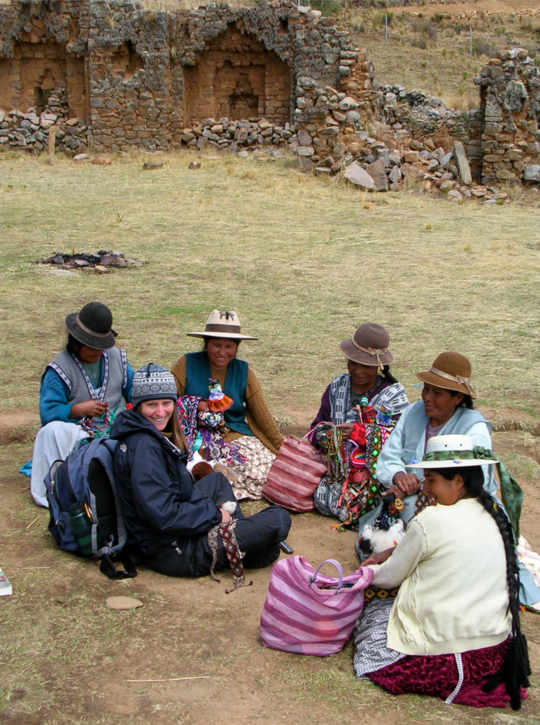
Talking with women weavers on the Island of the Moon, BoliviaThe story demands that I open my eyes to realities I would rather not consider. The Inca Empire is often idealized in the Andes today, and the monuments it left behind, such as Machu Picchu, are world-renowned treasures. Yet these creations were built by people laboring under a totalitarian god-king. I wrestle with how to honor the beauty and spirit of a society while acknowledging the suffering it must also have caused.
Finally, this journey requires me to face tragedies in our modern world, such as how climate change is impacting the Andes. Canadian anthropologist Wade Davis, in his book The Wayfinders: Why Ancient Wisdom Matters in the Modern World, states: “Eighty percent of the fresh water that feeds the western coast of South America is derived from Andean glaciers. These are receding at such an obvious rate that the pilgrims to the Qoyllur Rit’i [Snow Star Festival], believing the mountain gods to be angry, are no longer carrying ice from the Sinakara [Valley] back to their communities, forgoing the very gesture of reciprocity that completes the sacred circle of the pilgrimage and allows for everyone to benefit from the grace of the divine.” I am forced to consider the effects of this devastation, not only at an environmental and human scale, but also at the level of cosmology. I don’t want to imagine the mountain gods stripped of their regal white cloaks, the mantles of snow and ice that have inspired centuries of devotion and awe. But the journey of the story-carrier insists that I do.
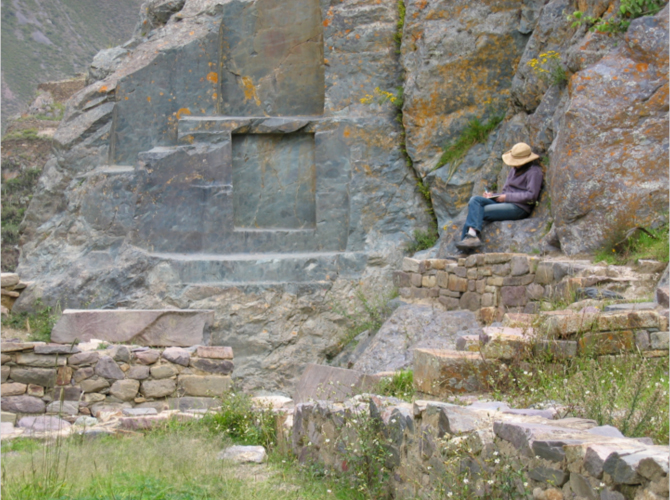 Writing at Inca site Ollantaytambo, Peru
Writing at Inca site Ollantaytambo, Peru
* * *
These days, there is not a lot of stillness in my life. My two young boys are whirlwinds circling around our small house, their needs and heartbreaks and joys constantly calling my attention.
Even when my children are out of the house, I am subject to the same forces as everyone in the plugged-in world. We live in an age of distraction, subject to the dominating influence of the screens we turn to for entertainment, information and connection. They are useful—perhaps essential for modern life—but they are attention-stealing machines, and we all know it. I go to my computer to write and can easily end up down a rabbit hole of classroom notices, work requests, and news of the latest tragedy somewhere on this big, beautiful earth.
Despite the logistical and psychological hurdles, I push myself to step out of the fast flow of my life in order to tend the story. I make the offering. This is the devotion of a thousand tiny steps. It is about showing up at the page as close to daily as I can muster, stringing writing sessions together like tiny beads on a strand. And in that preciously won time, I often struggle at the page, like every writer does. I get tangled up in the threads of the story. Sometimes I have to unweave line after line. This is the humbling work of daily practice, based on patience and persistence more often than grand leaps of inspiration.
* * *
On a writing retreat in Southern California, no snow-covered Apu in sight, Eagle Rock was the highest place nearby. I hiked to the top. On my offering cloth, I spread chocolate, coca, chamomile flowers, sage I picked along the trail, and the big-kernelled corn from Peru called choclo. I sprinkled water, the most precious gift in these drought-stricken hills. Afterwards, I bounded down the hill, exhilarated. At the bottom, I discovered a sliver of orange mullu—the sacred spondylus shell—had come out of my ring, bought a decade ago in Peru. Eagle Rock wanted more than the pago I left. Sometimes the gods take more than what is willingly offered to them.
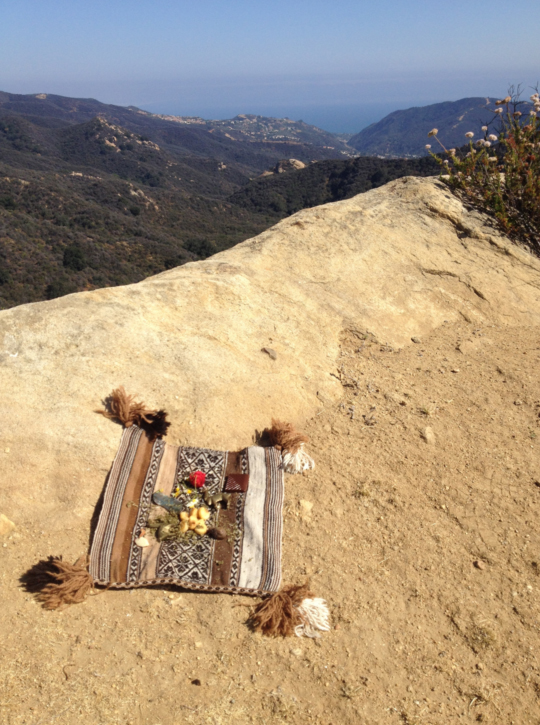
Offering at Eagle Rock, Southern CaliforniaThe night before, on a different kind of journey, the pounding of the drum led me out of these sage-scented hills to the top of a snow-covered Apu. There I met Bird Spirit, a swirl of purple-black, and Puma Spirit, tawny paws crossed in front of her. They did not care for many of my questions or requests for guidance. Irrelevant, they responded. Not our concern. Bird spit on the ground. But they knew what they wanted. Bird wanted birdseed scattered in the hills. Puma wanted blood—the bone buried in my yard—and a liberal dose of alcohol poured on top.
To them both, I swore my devotion to the story I have been given to carry. I offered up my pago—to pay attention—perhaps the most sacred of currencies in this age of distraction. I promised to tend the story as I tend my children, to stay on the path until the journey is complete. Bird and Puma were not impressed. They expected nothing less.
About the Author
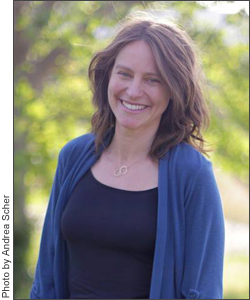
Rebecca Brams – is a writer and mother to two young boys in Berkeley, California. She grew up in California’s Mojave Desert and has traveled extensively in Latin America. She has a B.A. in Anthropology from Stanford University and an M.F.A. in Creative Writing from St. Mary’s College of California. Her fiction and creative nonfiction have been published in Carve Magazine, Literary Mama and on blogs, including her own, www.thismamawrites.com.
Return to top